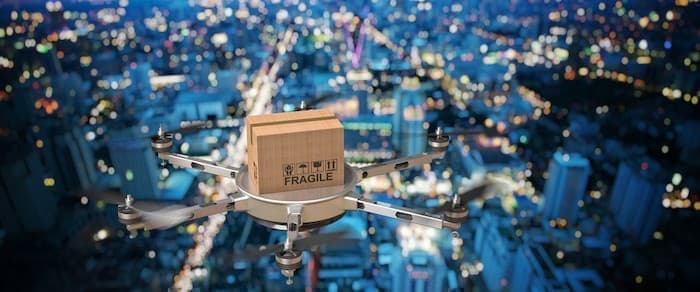With crude oil prices in the toilet, hundreds of millions of gallons of oil stranded in tankers around the world with no buyers, and an oil industry in chaos, it makes more sense than ever that the vehicles of the future will not run on gasoline and diesel fuel. Global industries have already been moving toward decarbonization, albeit very slowly in most cases, and the current energy crisis is sure to catalyze that energy transition. In fact, the World Economic Forum went as far as to implore policymakers and private-sector leadership to take advantage of this unprecedented disruption to ensure that the new world that emerges from the ashes of the novel coronavirus pandemic will be a much greener one.
So it stands to reason that a transition away from diesel-chugging delivery vehicles to delivery drones would be a nearly unilateral improvement. It will take untold legions of delivery trucks off the roads and out of traffic jams and high-polluting freight planes out of the sky. And it’s just around the corner. Aviation regulators around the world are already working with home-delivery giants like Amazon, UPS, and DHL to create legislation allowing these kinds of services to take flight. Amazon’s landing page for its new fleet of delivery drones, called Prime Air, makes big promises: “We're excited about Prime Air — a future delivery system from Amazon designed to safely get packages to customers in 30 minutes or less using unmanned aerial vehicles, also called drones. Prime Air has great potential to enhance the services we already provide to millions of customers by providing rapid parcel delivery that will also increase the overall safety and efficiency of the transportation system.” What could be the downside?
Related: Shale's Decline Will Make Way For The Next Big Thing in Oil Well, apparently there’s a big one. A new study by researchers from the Martin Luther Universitat in Halle-Wittenberg made the shocking discovery that delivery drones will use 10 times more energy than standard delivery vans. “Multicopter drones are a marvelous technology, but as aircraft, they're highly inefficient, writes New Atlas in a story based on the MLU report. “Lacking wings, which can develop lift by moving forward through the air, drones must constantly provide upward thrust just to keep themselves airborne. Add the weight of your grande burrito delivery, and they've got to pull even harder, and energy consumption goes up considerably when they've got to fly into a headwind or crosswind. Not to mention, they can only carry one parcel at a time, making every trip a round trip of its own.”
The dryly titled report “Comparison of energy demands of drone-based and ground-based parcel delivery services,” published this year in ScienceDirect academic journal, used a “detailed energy demand model for drones” to determine that “switching to a solely drone-based parcel delivery system is not worthwhile from an energetic perspective in most scenarios.”
Related: How Much Longer Will Indian Oil Demand Slump?
“Based on simulations run on Berlin and the surrounding areas, the researchers found that in dense urban areas, electric vans are by far the most energy-efficient delivery option,” reports New Atlas. “Diesel vans use around five times more energy in this situation, and drones use around 10 times as much.” This is because “population density is the key factor here; vans can carry literally hundreds of items at a time, and when delivery routes are short and packed with lots of drop-offs, minimal energy is wasted.” It’s not quite that simple, however. Nothing ever is. In rural scenarios, drones can actually be more energy-efficient than even electric vans. Further complicating the matter, the “greenness” of electric drones and vans also depends on the source of that electricity. If it’s coal-powered, that obviously compromises the sustainability and carbon footprint of both.
Overall, however, vans are the less energy-intensive vehicle by a wide margin, and electric vans are the most energy-efficient with the lowest greenhouse gas emissions overall, especially when that electricity comes from renewable resources, and drones are the big losers. I guess that explains why Prime Air doesn’t bother to make any eco-claims for their new airborne electric delivery vehicles, which are likely to be in a sky near you any day now.
By Haley Zaremba for Oilprice.com
More Top Reads From Oilprice.com:
- How Oil Prices Could Go To $100
- Oil Jumps After Trump Orders Navy To ‘’Shoot And Destroy’’ Iranian Gunboats
- Rig Count Collapse Continues Despite Jump In Oil Prices



















The solution is a vertical take off and landing (VTOL) aircraft, not much unlike the US Military OV-22 Osprey. There are multiple manufacturers with designs in production which offer this very feature.
Besides, no one sees drone as replacing every single cargo truck and airplane, at least not in the near term. Just like every tool, when used for the right job, drones do their jobs very well.
Thanks for tackling this. It's early days and clearly in densely packed areas the dynamics aren't the best. However, even there the vans could eventually be used as an aircraft carrier with a flock of drones, like the Wicked Witches flying monkeys, taking to the sky for the last mile.
However, out here in the Provinces, rather than jumping in my 1,000 lb chariot of steel and glass to go fetch a single Dr. Pepper or pound of butter, risking life and sea level rise, it would be two orders of magnitude (I'm guessing) more efficient to have either Hal, my personal drone, or Bezos' (preferably someone else's) unit bring it to me.
This particular lockdown would be a great time to have that capability, don't you think? Who doesn't need a drink about now?